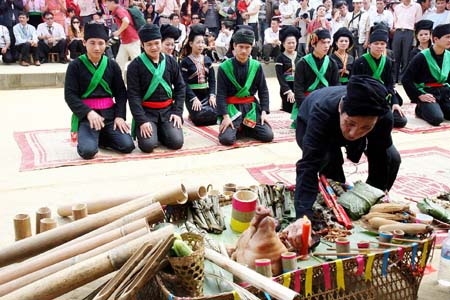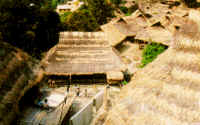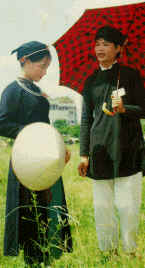The Gong mainly cultivate burnt-over land using traditional techniques of knives and fire and sticks to make holes to put seeds into the holes. Recently, they have used hoes to hoe land and oxen or buffaloes to draw ploughs. Apart from them, agriculture, food gathering and fishing play a major role in the Cong life. The Cong catch fish by hand or by using poisonous plants.
Cong women are unfamiliar with weaving. They grow cotton then use t to barter for cloth. Cong men and women are skilled at making basketry articles, particularly making rattan mats with red dyeing.
The Cong live in houses on stilts. Each house comprises three or four bays separated by partitions. The central bay is reserved for receiving guests. Only one entrance door is opened in one end of the house and a window in the central bay.
Each Cong lineage has a leader and its own taboos and manner of celebrating the worship of the ancestors, placing its altar. The patriarchal nuclear family is the nucleus of society. When the father dies, his eldest son will replace his position in the family.
In the past, only Cong men and women of the same group got married one another. Of late, they have accepted marriage with members of other ethnic groups such as the Thai and Ha Nhi. According to custom, persons of direct descent can get married only from the seventh generation. The man's family actively proposes marriage. After the betrothal, the man lives in his future wife's family for several years and women wear their hair knotted in a chignon on the top of their heads, which shows that they are married. The wedding is often celebrated when the couple has children. Then the man must offer to the parents of his wife pieces of silver money and a certain amount of other cash. The woman family must prepare dower for the bride to bring it to her husband's house. Several days after the wedding, the couple comes to visit the family of the wife.
The Cong follow their own calendar. A year has 12 months (each corresponding to an animal) and a month has 30 days.
The Cong's ancestors belonging to the second or third generation are worshipped. A ritual sacrifice to the souls of the ancestors is performed several times a year-at weddings, after harvest, at the birth of the child or upon the death of a relative. Like the Ha Nhi and La Hu, every year each Cong village holds a communal ceremony for the start of a rice crop. Besides, several rites are also held to pray for bumper crops and prosperity.
The Cong folk arts are d Verse with smooth melodies of alternating songs that they like to sing at the communal ceremonies.





